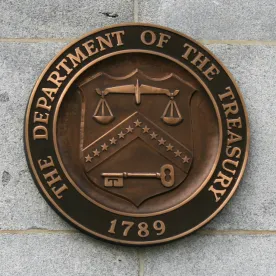-
Which domestic and foreign reporting companies must file reports with FinCEN regarding their beneficial ownership.
-
Who is a beneficial owner of a reporting company.
-
What information does FinCEN’s proposed rule require from reporting companies.
-
When would a reporting company need to submit to FinCEN a report identifying its beneficial owners
On Dec. 7, 2021, the U.S. Department of the Treasury’s Financial Crimes Enforcement Network (FinCEN) issued a notice of proposed rulemaking (NPRM) to implement the beneficial ownership information reporting provisions of the Corporate Transparency Act (CTA). The CTA is part of the Anti-Money Laundering Act of 2020 (AML Act) and generally establishes beneficial ownership information reporting requirements for certain types of corporations, limited liability companies, and other similar entities created in or registered to do business in the United States.
The rules proposed under this NPRM are part of three sets of rulemakings, which FinCEN intends to issue to implement the requirements of the CTA: a rulemaking to implement the beneficial ownership information reporting requirements (this NPRM); a second rulemaking to implement the CTA’s protocols for access to and disclosure of beneficial ownership information; and a third rulemaking to revise the existing customer due diligence requirements for financial institutions (CDD Rule).
The NPRM addresses, among other things: (1) which entities must report beneficial ownership information; (2) what information they must provide; and (3) when they must report. This GT Alert provides an overview of each of these three categories.
Comments in response to the NPRM are due Feb. 7, 2022. It is unclear when FinCEN will issue final rules to implement the CTA, but we expect them to be issued in 2022.
Which entities must file a report under the proposed rule, and who are their beneficial owners?
Under the NPRM, the following domestic and foreign reporting companies must file reports with FinCEN regarding their beneficial ownership:
-
Domestic Reporting Companies: Any corporation, limited liability company, or other similar entity created by the filing of a document with a secretary of state or similar office of a jurisdiction within the United States is deemed a domestic reporting company, unless exempt under the CTA.
- Foreign Reporting Companies: Similarly, under the CTA, a foreign reporting company is any entity (e.g., corporations, limited liability companies, or other similar entities) formed under the law of a foreign jurisdiction that is registered to do business in a certain state within the United States.
Reporting company exemptions: Despite the broad inclusion of legal entities under the CTA’s definition of a reporting company, 23 types of entities are exempt from the definition of reporting company, including:
-
issuers of a class of securities registered under section 12 of the Securities Exchange Act of 1934 or that are required to file supplementary and periodic information under section 15(d) of the Securities Exchange Act of 1934;
-
entities already required to disclose beneficial ownership information publicly or to federal regulators – e.g., banks, credit unions, depository institution holding companies, insurance companies, registered money transmitting businesses, broker/dealers, investment companies, and investment advisers;
-
public accounting firms registered in accordance with section 102 of the Sarbanes-Oxley Act of 2002;
-
a large operating company, which is any entity that: (1) employs more than 20 employees on a full-time basis in the United States; (2) filed in the previous year federal income tax returns in the United States demonstrating more than $5,000,000 in gross receipts or sales in the aggregate, including the receipts or sales of other entities owned by the entity and through which the entity operates; and (3) has an operating presence at a physical office within the United States; and
-
any corporation, limited liability company, or other similar entity of which the ownership interests are owned or controlled, directly or indirectly, by, among other entities, the entities listed above.
While FinCEN proposes to adopt largely verbatim the statutory language granting the 23 exemptions specified under the CTA, the NPRM makes certain clarifications to such statutory language, particularly with respect to each factor of the “large operating company” exemption, as summarized in the subsequent paragraphs.
Changes to the “large operating company” exemption. With respect to the “large operating company” exemption, FinCEN proposes to clarify what it means to employ someone on a full-time basis by referencing the Internal Revenue Service definition of full-time employee, which generally counts as a full-time employee anyone employed an average of at least 30 service hours per week or 130 service hours per month, with adaptations for non-hourly employees.
Second, regarding the $5,000,000 filing threshold, FinCEN proposes to make clear that the relevant filing may be a federal income tax or information return, and that the $5,000,000 must be reported as gross receipts or sales (net of returns and allowances) on the reporting entity’s IRS Form 1120, consolidated IRS Form 1120, IRS Form 1120-S, IRS Form 1065, or other applicable IRS form, excluding gross receipts or sales from sources outside the United States, as determined under federal income tax principles.
Finally, under the NPRM, an entity with an “operating presence at a physical office within the United States” would be one for which the physical office is owned or leased by such entity, is not a residence, and is not shared space (beyond being shared with affiliated entities)—in sum, a genuine working office of the entity.
Who is a “beneficial owner”? Under the CTA, a beneficial owner of a reporting company is “any individual who, directly or indirectly, through any contract, arrangement, understanding, relationship, or otherwise—(i) exercises substantial control over the entity; or (ii) owns or controls not less than 25% of the ownership interests of the entity.” Because the CTA does not define either “substantial control” or “ownership interest,” FinCEN intends to define each such term as follows:
- Substantial Control: The NPRM proposes three specific indicators of substantial control: (1) service as a senior officer of a reporting company; (2) authority over the appointment or removal of any senior officer or dominant majority of the board of directors (or similar body) of a reporting company; and (3) direction, determination, or decision of, or substantial influence over, important matters of a reporting company. The proposed regulation also includes a catchall provision to make clear that substantial control can take additional forms not specifically listed.
- Ownership Interest: The NPRM proposes that “ownership interest” would include both equity in the reporting company and other types of interests, such as capital or profit interests (including partnership interests) or convertible instruments, warrants or rights, or other options or privileges to acquire equity, capital, or other interests in a reporting company. Debt instruments would also be included if they enable the holder to exercise the same rights as one of the specified equity or other interests.
Who is not a “beneficial owner”? The following five types of individuals are exempt from the definition of “beneficial owner”:
-
a minor child (as defined under the state law where the reporting company is formed or first registered);
-
an individual acting as a nominee, intermediary, custodian, or agent on behalf of another individual;
-
certain employees of a reporting company, acting solely as an employee and not as a senior officer;
-
an individual whose only interest in a reporting company is a future interest through a right of inheritance; and
-
certain creditors of a reporting company.
What information does the proposed rule require?
Under the CTA, reporting companies must submit to FinCEN a report identifying each beneficial owner of the reporting company and each company applicant1 by the following information: (1) full legal name, (2) date of birth, (3) current residential or business street address, and (4) unique identifying number from an acceptable identification document (or, if information has already been provided to FinCEN, by a FinCEN identifier).
Expanding on the CTA, the NPRM would also require reporting companies to report certain information to identify the reporting company. The proposed regulations would require each reporting company to report its name, any alternative names through which the company is engaging in business (“d/b/a names”), its business street address, its jurisdiction of formation or registration, as well as a unique identification number such as an Employer Identification Number (EIN), or where a reporting company has not yet been issued an EIN, a Dun & Bradstreet Data Universal Numbering System (DUNS) number or a Legal Entity Identifier (LEI).
To implement such requirements, the NPRM specifies that each report or application must be filed with FinCEN in the form and manner FinCEN prescribes (which is yet to be determined by FinCEN), and each person filing such report must certify that the report is accurate and complete (the form of such certification is also yet to be determined by FinCEN).
When would an entity need to report?
The rule proposed under the NPRM does not take effect until after FinCEN has considered public comments and issued its final regulations. While the date in which FinCEN will issue final regulations to implement the CTA is not certain, we expect it to occur in 2022.
Once the final regulations related to this NPRM take effect, the time at which a required report is due would depend on:
-
when the reporting company was created or registered; and
-
whether the report is an initial report, an updated report providing new information, or a report correcting erroneous information in a previous report.
Generally, reporting companies will be required abide by the following timeframes:
-
One Year for Existing Companies: Domestic reporting companies created, or foreign reporting companies registered to do business in the United States, before the effective date of the final regulations would have one year from the effective date of the final regulations to file their initial report with FinCEN.
-
14 Calendar Days for New Companies: Domestic reporting companies created, or foreign reporting companies registered to do business in the United States for the first time, on or after the effective date of the final regulations would be required to file their initial report with FinCEN within 14 calendar days of the date on which they are created or registered, respectively.
-
30 Calendar Days for Updates: Reporting companies would have 30 calendar days to file an updated report if there is a change in the information previously reported to FinCEN.
-
14 Calendar Days for Error Corrections: If a reporting company filed information that was inaccurate at the time of filing, the reporting company would have to file a corrected report within 14 calendar days of the date it knew, or should have known, that the information was inaccurate.
.
Potential future impact of additional rulemaking
In addition to issuing the beneficial ownership reporting rules under the NPRM, as previously mentioned, FinCEN also intends to issue two sets of rulemakings that would impact how financial institutions comply with their regulatory requirements under the Bank Secrecy Act of 1970, as amended, and other anti-money laundering/countering terrorism financing (AML/CFT) laws. First, FinCEN will likely issue a rulemaking to implement the statute’s protocols for access to and disclosure of beneficial ownership information, and second, a rulemaking to revise the existing CDD Rule.
The CTA requires that FinCEN rescind and revise portions of the current CDD Rule within one year after the effective date of the beneficial ownership reporting rules proposed under the NPRM. The current CDD Rule, which financial institutions have spent considerable time and resources implementing, requires certain financial institutions to identify and verify the beneficial owners of legal entity customers when those customers open new accounts, as part of those financial institutions’ customer due diligence programs. FinCEN intends to make changes to the CDD Rule to conform with the requirements under the CTA.
The CTA identifies three purposes for a revision of the CDD Rule: (1) to bring the rule into conformity with the AML Act as a whole, including the CTA; (2) to account for financial institutions’ access to beneficial ownership information reported to FinCEN “in order to confirm the beneficial ownership information provided directly to the financial institutions” for AML/CFT and customer due diligence purposes; and (3) to reduce unnecessary or duplicative burdens on financial institutions and legal entity customers.
FinCEN intends to satisfy the requirements related to the revision of the CDD Rule through a future rulemaking process that will provide the public with an opportunity to comment on the effect of the final provisions of the beneficial ownership reporting rule on financial institutions’ customer due diligence obligations.
Conclusion
As previously indicated, FinCEN is accepting comments in response to the NPRM until Feb. 7, 2022.
Legal entities potentially impacted by these proposed beneficial ownership reporting rules, which are seeking advice on the NPRM, or seeking general assistance with the current BSA/AML reforms, are encouraged to consult with experienced financial regulatory counsel.
1 A “company applicant” is defined under the NPRM as the individual who files the document that forms the entity in the case of a domestic reporting company. In the case of a foreign reporting company, a company applicant is defined as the individual who files the document that first registers the entity to do business in the United States.







 />i
/>i

